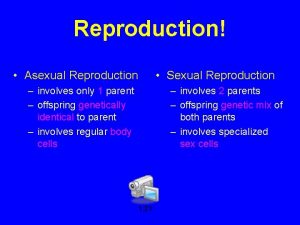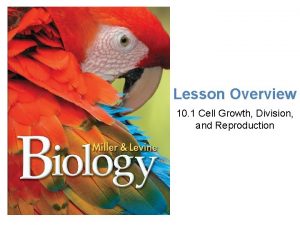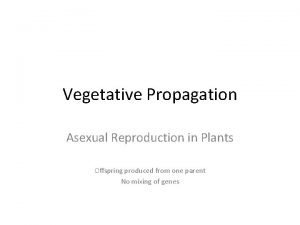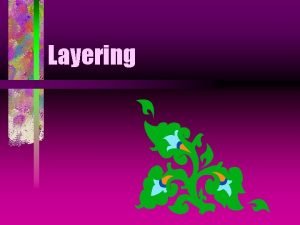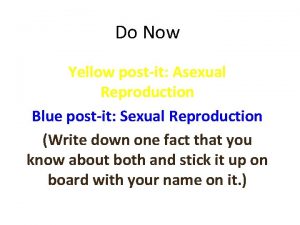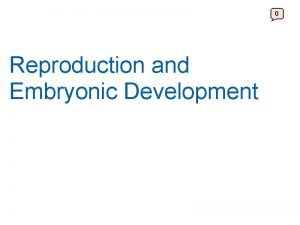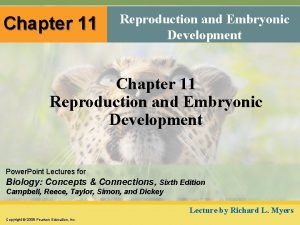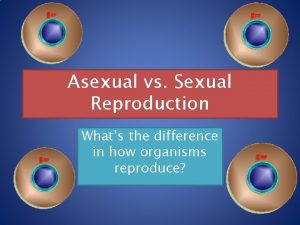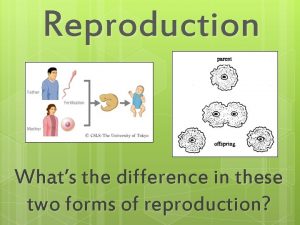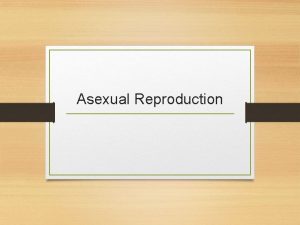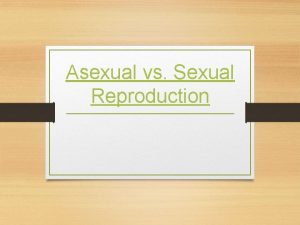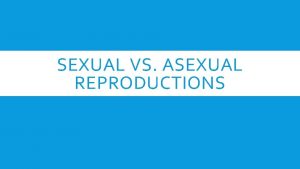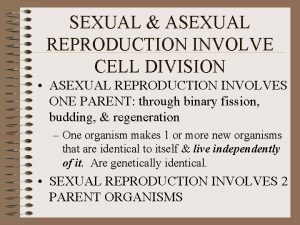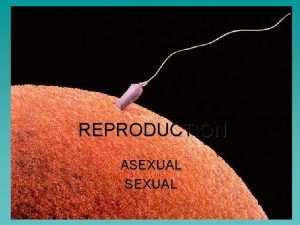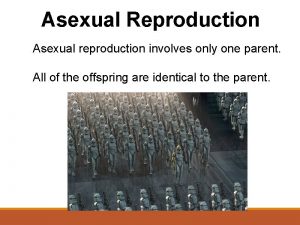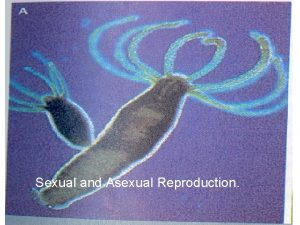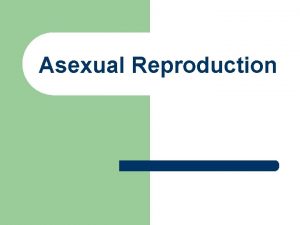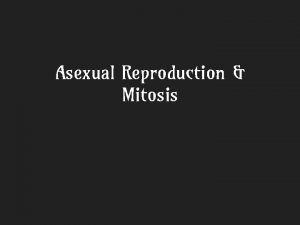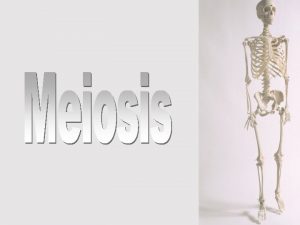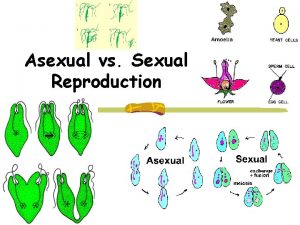Cell Division Asexual Reproduction One Parent Producing Identical




















- Slides: 20

Cell Division: Asexual Reproduction One Parent Producing Identical Offspring

Pros and Cons of Asexual Repro • Pros • Good Traits Consistently carried on Cons No mate required (quick and easy) No mixing of genes Evolution less likely Greater variety feeds Evolution Bad Traits Too!

Types of Asexual Reproduction • Binary Fission : – Binary Fission – a form of cell division that results in production of two daughter cells about the same size. – Single-celled (unicellular) Organisms • Bacteria • Protozoa (Paramecium, Ameba)

Bacteria can double their population every 20 minutes

Binary Fission: Paramecium Amoeba • Paramecium Ameba

Budding: Another Type of Asexual Repro • Budding is characterized by the unequal division of the cytoplasm during cytokenesis Examples: Yeast – single-celled Fungi used in the wine and baking industries (Also, some cause Athletes Foot and “Ring Worm”) – Hydra – Small multicellular water animal related to the Jellyfish

Budding • Budding Yeast B u d d Budding Hydra

Spore Formation: “sporulation” • Spores are single, specialized cells that can be produced either sexually or asexually. When released, spores germinate and grow into new individuals – Bread Molds – Mushrooms

Sporulation • Spores can withstand extreme Conditions (heat, cold, dry) Bread Mold Spores Mushrooms produce spores Under cap, in “gills”

Regeneration: Ability to grow a part of OR an entire individual • Some organisms can re-grow missing or injured parts through " regeneration” – “Undifferentiated Cells” near the affected site are capable of growing missing parts Salamanders can regenerate Legs and Tails

Regeneration of Entire Organisms Sea star can re-grow limbs and even Another sea star Planarian

Plants and Asexual Repro • Vegetative propagation — Plants can form from stolons, rhizomes, tubers, corms, and bulbs. Vegetative propagation is an example of asexual reproduction because no exchange of pollen is involved.

Vegetative Propagation: Ways that Some Plants Reproduce Asexually • Runners – shoots coming from the parent plant on top of the soil, will “root” when conditions are right and grow into another plant, identical to the parent Strawberries Poison ivy

Pieces of plant, root into whole new plant • Cuttings: pieces of leaf, and/or stems will root and grow into • Whole new plant

Bulbs, Tubers, “Eyes” • New plants can arise from special regions

What Limits Regeneration, and Vegetative Propagation? • Organisms that are capable of regenerating entire body parts Or creating a new individual identical to itself possess special regions of cells that are UNDIFFERENTIATED • This means they can become any other type of cell

Why We Can’t • Humans and other more complex vertebrates have cell lines that are too specialized to become any other types of cells under normal conditions • We are capable of repairing dead or damaged cells only from cells of the same cell line (skin cells replace skin cells) • But Skin cells cannot replace brain cells

The Question of Stem Cells • Stem cells are cells that give rise to a variety of different cells (Bone marrow cells give rise to RBC, WBC, and platelets) • The only time during our development that our cells can develop into any other type of cell is during the earliest stages of embryonic development (first 4 -7 days following conception)

Cells from Bone Marrow Of Adults can produce Not only, RBC , WBC And Platelets, BUT Also Skeletal and Cardiac Muscle Adult Stem cells ma “MULTIPOTENT”

Embryonic Vs. Adult Stem Cells • Embryonic = Totipotent (can become any • Other cell)
 Asexual reproduction cell division
Asexual reproduction cell division Asexual reproduction cell division
Asexual reproduction cell division Sexual reproduction and asexual reproduction
Sexual reproduction and asexual reproduction Asexual vs sexual reproduction venn diagram
Asexual vs sexual reproduction venn diagram Involves only one parent
Involves only one parent Identical by descent vs identical by state
Identical by descent vs identical by state Cell growth division and reproduction
Cell growth division and reproduction Vegetative propagation
Vegetative propagation Examples of asexual reproduction
Examples of asexual reproduction Do worms reproduce sexually or asexually
Do worms reproduce sexually or asexually Parthenogenesis in mammals
Parthenogenesis in mammals Types of asexual reproduction and examples
Types of asexual reproduction and examples Asexual propagation layering
Asexual propagation layering Benefits of sexual propagation
Benefits of sexual propagation Asexual reproduction
Asexual reproduction Gastrula
Gastrula Whats asexual reproduction
Whats asexual reproduction Sexual reproduction in organism
Sexual reproduction in organism Chapter 19 asexual reproduction
Chapter 19 asexual reproduction Difference of sexual and asexual reproduction
Difference of sexual and asexual reproduction Whats a sexual reproduction
Whats a sexual reproduction




